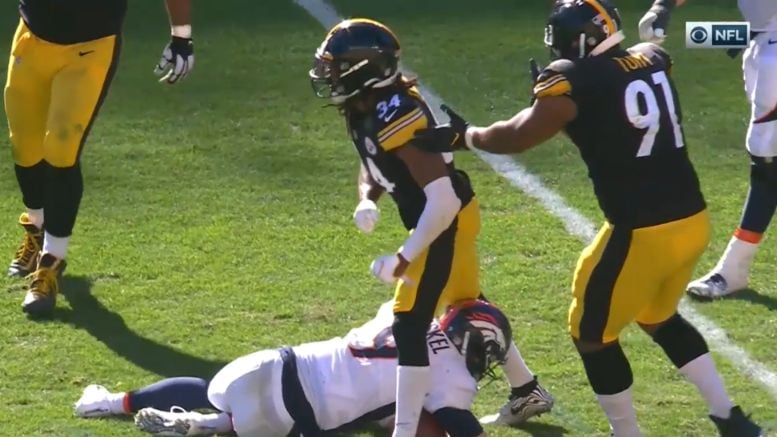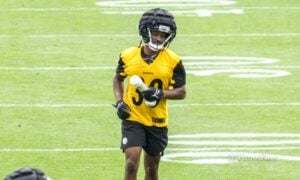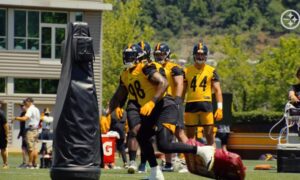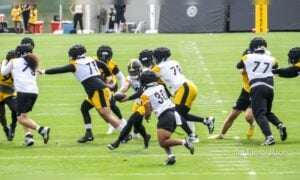Although Edmunds lacks turnover creation, with just three interceptions and zero forced fumbles to his credit in 47 career games, it’s been impossible to ignore his improvement from year to year, as he has undeniably become an increasingly versatile and valuable piece to one of the league’s top defenses. In fact, last season, Terrell Edmunds posted his best campaign to date, tallying 68 tackles, a tackle for a loss, and a sack to go along with a pair of interceptions and eight pass defenses, both figures which doubled his previous career high.
That being said, raw stats don’t even begin to tell the story of Edmunds impact on the 2020 Pittsburgh defense, as his increased ability to play within the box effectively, serve as the team’s primary “cap defender” in the Keith Butler’s frequently schemed Nickel blitzes, and expand his zone coverage versatility to open the door for Minkah Fitzpatrick’s role to further expand provided immeasurable value to a top-tier defensive unit.
Thus, today, we’ll be taking an extended look into Edmunds’ ability to perform in three distinct roles, as a box defender, in various zone coverage assignments, and in man coverage assignments. Moreover, although most fans seem to be searching to replace Hilton’s contributions with whoever rises to assume the Nickel cornerback role, I’ll explain how Edmunds can potentially help replace Hilton’s contributions if the team is able to find a capable third safety either from this years draft class in Tre Norwood, or more likely in a camp free agent add such as the often rumored Malik Hooker.
Terrell Edmunds as a Box Defender
Although he has traditionally served as the teams starting strong safety ever since assuming the role immediately exiting camp as a rookie, the 2020 season saw Edmunds playing in the box with far greater frequency. Particularly, Edmunds served in two distinct box roles, most frequently playing off ball at linebacker depth, while also being deployed at a healthy rate as a traditional edge defender, where he was deployed as a blitzer with more frequency. While his ability to rush the passer has yet to progress much from his rookie campaign, he displayed an increased ability to fill gaps, flatten down the line off the edge, and shed blocks from interior lineman to stay clean and impact the battle at the line of scrimmage, using his 6’1”, 215-pound frame to his advantage.
In what would be categorized as his most impactful play of the 2020 season, a game-clinching fourth down sack to halt a Broncos comeback effort late in a Week 2, 26-21 victory, Edmunds aligns as an edge defender in a five-man front alongside T.J. Watt. After a bluffed A-gap blitz from Mike Hilton slid the Broncos’ protection away from Edmunds, the third-year safety capitalized on the diversion of attention, flying off the edge unblocked, closing to the upfield shoulder, and securing the turnover on downs with an efficient form tackle.
While the sack is certainly more the product of Butler and Tomlin’s defensive schematics, the attention to detail taken by Edmunds, to attack the top field shoulder, closing off the quarterbacks escape lanes, and executing a form tackle, ensure that this rep doesn’t turn into a broken play, scramble drill situation.
While Edmunds’ pass rush abilities off the edge could certainly stand to improve, his run defense off the edge produced nothing short of exceptional contributions from the safety position. Below, once again aligned to the edge alongside T.J. Watt in a five man front, Edmunds out-leverages Corey Davis’s down block, quickly knifing inside at the snap, absorbing the contact and tripping up the All-Pro Derek Henry from the ground in Polamalu-esque fashion, halting the league’s leading rusher for a minimal gain.
Note Edmunds reading his keys, identifying the line down blocking away from him, and tracking the run down from the backside, a play we have witnessed T.J. Watt and Bud Dupree make with frequency, but an extremely high-level play from a safety nonetheless. Unlike many of his peers at the safety position league-wide, Edmunds was able to prove repeatedly that he is simply too functionally strong and physical at the point of contact to be effectively blocked by wide receivers.
This time, playing as an off ball outside linebacker, playing alongside Robert Spillane and Vince Williams behind a five-man front, Edmunds walks towards the line of scrimmage pre snap, following Mike Thomas in motion, before once again proving that assigning a wide receiver to block him in the box is a futile attempt. At the snap, Edmunds once again reads his keys, following the left tackles down block into the C-gap, beating Mike Thomas across his face with an aggressive rip move, disengaging, flattening down the line, and stuffing Giovanni Bernard after a minor gain with an impressive form tackle.
Note that unlike many safeties league-wide, Edmunds comes downhill efficiently and aggressively when playing from within the box, allowing the Steelers to keep speed on the field while not compromising their ability to defend from within the box, similar to their former Nickel cornerback and current Cincinnati Bengal, Mike Hilton.
While Hilton possessed an uncanny knack for timing his blitzes that Edmunds likely will never come close to replicating, his ability to defend bring speed and physicality within the box, while simultaneously serving as an adequate man coverage defender leads me to believe that he could play more within the box if the team can identify an adequate option to serve as the team’s third safety in sub packages.
Once again aligning along the line of scrimmage, this time inside of Edge defender T.J. Watt, shading inside of the right tackle in the five man front, Edmunds produces a solid, if not flashy rep, although I believe it was his most impressive box rep of the season. At the snap, Edmunds attempts to beat tackle Terrance Steele across his face, but gets engaged on as the line flows left in their zone blocking assignment. Edmunds continues to flow down the line, holding his ground against the powerful Steele despite giving up nearly 100 pounds, before disengaging and dropping Zeke Elliot with an efficient form tackle after a short gain.
While maybe less visually impressive than watching him knife into the backfield and disrupt plays immediately, Edmunds showcasing the ability to hold his ground against an NFL caliber right tackle truly shows the versatility and importance that he brings to the Steelers defense.
Thus, as I stated earlier, the Steelers have the replacement for Mike Hilton’s vacated Nickel spot in house, whether it is ultimately Cam Sutton, Shakur Brown, Arthur Maulet, or somebody else will be determined in camp. That being said, the harder contributions to replace are Hilton’s ability to allow the Steelers to play Nickel against heavy run personnel due to his ability to penetrate the line of scrimmage and produce tackles for losses.
In that space, I strongly believe if the team is able to ultimately sign a Malik Hooker, than their best option in replacing Hilton’s contributions could be deploying a Big Nickel package on early downs, with Minkah and the third safety playing deep, while Edmunds plays as a box defender, providing necessary speed to the front seven.
Terrell Edmunds in Zone Coverage
While Edmunds is never going to be the most natural fit in the post safety role, his ability to swap roles with Minkah Fitzpatrick on an increased basis allowed Minkah to flourish as a robber defender in the Steelers favorite Cover 1 sets. After aligning in a two-high shell below, the Steelers roll into Cover 1 robber, with Minkah rolling down to occupy the intermediate middle of the field and Edmunds rotating to the post as the single-high safety.
As Lock evades pressure, escaping the pocket to his right and producing a scramble drill situation, Edmunds showcases his improved range, flowing all the way from the opposite hash to break up a pass along the sideline, nearly securing an impressive interception in the process. As I previously noted, Edmunds’ eight passes defended this season were more than the seven he had recorded in his first two seasons combined, a testament to his improving ability to effectively contest passes at the catch point, a skill which has often been categorized as his biggest pitfall as a young player.
Although his increased usage as the teams post safety produced some positive results, Edmunds’ growth as an underneath zone defender, primarily in his work as the hook/curl defender in the teams Cover 3 schemes, truly showcased his growth in the football IQ department.
Below, serving as the hook/curl defender in a Cover 3 scheme on third and long, stays patient eying the quarterback at the sticks before undercutting Tannehill’s pass for a near interception. While Edmunds once again misses a chance to create a turnover, his maturity as a player is evident on this rep with his ability to stay patient at the sticks, allow routes to distribute in front of him, and allow the quarterback’s eyes to lead him into the throwing window where he can make a play on the football without vision on the intended target.
Fast forward four weeks ahead in a blowout victory against the Jake Luton led Jacksonville Jaguars, Terrell Edmunds learned from his Week 7 drop to secure an impressive interception while operating in an identical situation, serving as the hook/curl defender in a Cover 3 scheme on third and long. This time, the Steelers run an inverted Cover 3, aligning pre-snap in a two high shell before buzzing both safeties down to the sticks in hook/curl zones with Mike Hilton traveling from linebacker depth to occupy the post safety role.
At the snap, Edmunds once again shows beautiful patience, staying planted at the sticks and reading the eyes of Jake Luton before triggering on the throw, high-pointing the football and tipping it to himself to secure his second interception of the game. Plays like this show Edmunds ability to learn from previous reps and continue to grow as a player, not just each off season, but on a game to game basis as well.
Perhaps Edmunds’ best contribution to the defense as a zone coverage defender is his status as the most physical and consistent open field tackler in the secondary. Below, once again serving as a hook/curl defender in a Cover 3 scheme with the Ravens attempting to convert a third and medium, Edmunds rolls down patiently, occupying intermediate throwing windows and attempting to force a checkdown.
Almost immediately, after seeing RG3 hit his checkdown shy of the sticks, Edmunds rallies to the underneath throw, arriving at the catch point with physicality to drive the pass catcher to the ground well short of the sticks, forcing a Ravens punt. Plays like this show Edmunds’ physicality, and ability to get ball carriers to the ground efficiently both in the box and in the open field, making it unsurprising that he led the starting secondary with a missed tackle rate of just 9.2% this past season, per our own Josh Carney’s tracking data.
Terrell Edmunds in Man Coverage
It’s no secret to NFL fans that Butler, Tomlin, and company have blitzed their Nickel cornerbacks, primarily Mike Hilton, at a higher frequency than almost any other defense league wide. Given that the Steelers are now a predominantly man coverage-centric unit, particularly in their tendency to deploy Cover 1 sets behind their five man pressure schemes, the scheme itself is heavily dependent on having an effective man coverage defender on the backend to “cap” their nickel blitzes.
Thus, while Edmunds improved in nearly all facets of his game during his 2020 campaign, few aspects of his game were more impressive than his ability to provide effective man coverage from “catch technique” as a cap defender, disguising his assignments well by varying his pre snap alignments.
Below, capping the blitzing Vince Williams to assume a man coverage assignment on the running back, Edmunds slowly rolls down toward the line of scrimmage pre snap before triggering immediately to the flat, closing space rapidly to the upfield shoulder, and arriving with physicality at the catch point to force the incompletion.
Where many safeties would hesitate or break down at the point of contact, Edmunds’ ability to trust his eyes and accelerate through the point of contact helped secure the impressive pass break-up on this rep.
As a current player who constantly begs my coaches to blitz more, one of their main responses is that until they fully trust us as tacklers, they can’t be comfortable in blitzing. Echoing that sentiment, similar to his zone coverage work, Edmunds’ most valuable contribution in his work as a cap blitzer stems from his ability to tackle effectively after the catch.
Below, serving as a cap defender to the blitzing Mike Hilton in a man coverage assignment on Greg Ward, Edmunds stays patient and square at the snap, waiting for the receiver to declare his outward break before attacking the upfield shoulder with outside leverage to force Ward to stop his feet and shooting low to secure the fundamentally sound tackle. While it may appear to be a routine tackle, we frequently see safeties across the league fail to maintain proper leverage and close ground when breaking toward the sideline in similar situations, often allowing the pass catcher enough room to work along the sideline for extra yards after the catch.
If you asked Keith Butler and Mike Tomlin what they expect their Nickel blitzes to look like when properly executed, they would show you the Week 5 example below against Cleveland’s play action bootleg concept. At the snap, Edmunds rolls down to cap the blitzing Mike Hilton, picking up David Njoku as he exits to the flat, closing to the tight ends upfield shoulder, and finishing with physicality to dislodge the ball, finishing to play the pocket at the catch point and force the pass breakup. As Hilton’s pressure forced Baker to hit his checkdown option in order to avoid the sack, forcing the ball into Edmunds tight coverage on the targeted David Njoku, leading to a timely pass breakup, this perfectly executed Nickel pressure is a perfect example of rush and cover working in tandem.
The final rep we’ll be taking a look at today, a goal line rep against the Titans talented tight end Jonnu Smith, might be my favorite rep by Terrell Edmunds all season, as it shows that the game is seeming to slow down for him, and he is allowing his instincts to take over.
At the snap, Edmunds briefly bites on the play fake, stepping downhill before flipping his head and hips almost instantaneously, closing to the catch point on a direct and efficient angle, and finishing through the tight end’s hands with physicality at the catch point to secure the touchdown-saving pass break-up. In the past, Edmunds has seemingly had trouble trusting his instincts and processing information efficiently, so reps like this show how far he has truly come in the football IQ and read and react ability facets of his growing game.
Thus, while Terrell Edmunds may never live up to the first-round billing which he received on draft night, he has quietly developed into one of the most versatile and valuable pieces to a defense that has been nothing short of elite over the past two seasons. While I was slightly surprised that the team declined his fifth-year option, his lack of turnover creation directly contradicts Teryl Austin’s takeaway-centric philosophy, which makes the decision easier to understand.
Nonetheless, even if 2021 is ultimately Edmunds’ final season in Pittsburgh, don’t be surprised if it’s his best season to date. Moreover, while the turnover creation may never be there, Edmunds’ physicality and relentless motor in pursuit of the football leads me to believe that he can carve out a long and successful career, potentially making the full-time transition to linebacker at some point in his career, similar to former Steelers fan favorite (incoming joke), Mark Barron! Let me know your thoughts on Terrell Edmunds ahead of the 2021 season below in the comments, and I will try to answer any possible questions.








